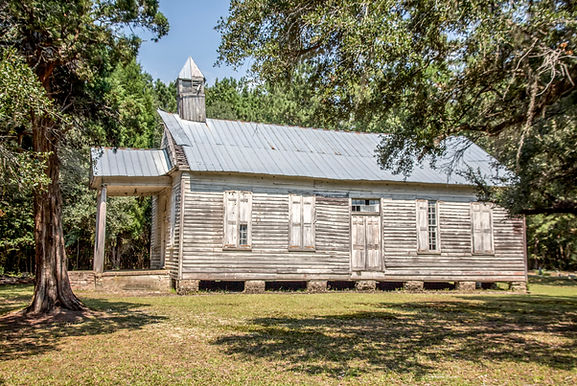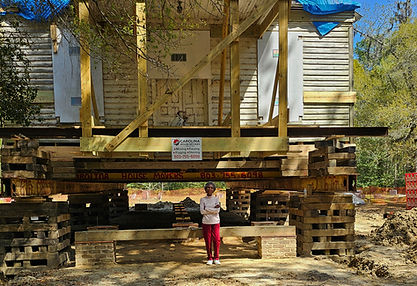
Taveau Church
“No pillar of the African American community has been more central to its history, identity, and social justice vision than the Black Church.”
Dr. Henry Louis Gates, Jr. Professor, Historian, Filmmaker, and Advisor of African American Cultural Heritage Action Fund
"Taveau’s restoration, however, is about more than just preserving a historical structure because of its unique architecture. It would also be a testament to the faith of the Black men and women who preserved Taveau as a place for their worship and coincidentally, passed down 175 years of Black worship experience including inspired preaching and soulful spirituals. Taveau tells this important story as well as the story of the local area, its land, its people, and its culture."
—Reverend Clayton J. Jones, Sr.
A Sacred Space for the Ages

History
Martha Caroline Swinton Ball Taveau, wishing to worship as a Presbyterian amidst the Cooper River Episcopalians, built Taveau on Clermont Plantation in 1835.
Taveau, built during a tumultuous time, is an eyewitness to our nation’s history and an important site in the Gullah Geechee Cultural Heritage Corridor. The expertise of the early enslaved Africans created the infrastructure that allowed the cultivation of rice to occur along the southeast Atlantic coast, most profoundly in the SC Lowcountry. There is no available information that tells us what the enslaved were taught during Taveau’s “Presbyterian era” (1835-1847).
In 1847, upon the death of Mrs. Taveau, the church became the worship home for Black Methodists. Taveau was likely part of a Methodist Mission Circuit based in Charleston, a relationship that reflected the growth of Methodism in America in the 19th Century.
After the Civil War, and when a new Black Methodist Conference was organized, Taveau began a new page in its history. The unique strains of Gullah Geechee culture were reflected in the worship and development of community in this rural area. Taveau stood not only as a sentinel to the trials and accomplishments of its congregants but the activities within its walls helped shape the character of its people and community through Reconstruction, Jim Crow, and Civil Rights eras. By the early 1970’s Taveau’s congregation dwindled so it merged with a nearby congregation in Cordesville and the church ceased to be used.


Architecture
Taveau is a rare surviving rural, frame antebellum church. It is a plain building, the exterior marked by modest cornice and a simple Doric portico. The simplicity of the interior during its first decades of use fit an aesthetic that is both rural and evangelical.
Materials were procured locally. Lumber, most likely sawn on site, provided the elements of the building’s structural components. Local timber was also sawn and planed into the twelve-light double row transoms set over the entrances, the sixteen light windows and their paneled shutters.
Building material incorporated in Taveau and the methods used in its construction express the skill of enslaved craftsmen.
Changes made to the interior of the church in the late nineteenth and twentieth centuries reflect the evolving character of worship expressed by the progeny of the church’s builders.
Timeline
In late June, 2023, and with the full support of the congregation, its ministers, and the Taveau Legacy Committee, we purchased historic Taveau from the United Methodist Conference.
Taveau is a remarkable survivor of a rural black church with rich history. For over 125 years Taveau was an active place of worship and gathering for Blacks.
This multi-year restoration project will return the historic church to usefulness as a local community space that is befitting of Taveau’s history and cultural legacy. We hope that you support this effort.

This project received funding from the African American Cultural Heritage Action Fund of the National Trust for Historic Preservation, with support from the Lilly Endowment, Inc., the South Carolina Department of Archives and History State Grant Fund, and Berkeley County Tourism.
Emergency Stabilization
On December 26, 2023, the project was mobilized with preservation contractor, Meadors, Inc. Building materials, a storage container, temporary power, and portable water placed on site. Temporary stabilization framing put in place in preparation for lifting the structure. Steel, blocking, and equipment necessary to lift the structure mobilized on site. The portico columns were removed, stored, and replaced with temporary columns.
On February 1, 2024, Taveau was lifted from its piers approximately six feet and blocked into place while a new foundation was built and new sills installed. Following the lift, the original brick piers were removed, cleaned, and secured on site for use in constructing new piers.
On March 22, 2024, Taveau was lowered onto its new footings and piers.


2024 Whitelaw Founders Award
from
The Historic Charleston Foundation
On April 25, 2024, Preservation SC, along with the Taveau Legacy Committee, received the Whitelaw Founders Award from the Historic Charleston Foundation for Taveau Church. Each April, Historic Charleston Foundation (HCF) commemorates its 1947 founding by honoring extraordinary contributions in preserving Charleston’s irreplaceable historic built environment and cultural character. The Whitelaw Founders Award “recognizes individuals, groups, or government entities that are committed to the long-term protection and preservation of important buildings and places, as well as those involved with preservation advocacy and policy.”
Our work would not be possible without our partners for which we are grateful.




Project Partners
Taveau Legacy Committee
South Carolina Department of Archives and History
Berkeley County Tourism
The Asiko Group
Meadors, Inc.
BVL Historic Preservation Research
Mepkin Abbey
Historic Charleston Foundation


















